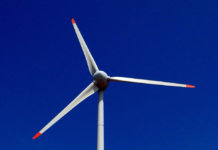Wind energy development does not ruffle the feathers of greater prairie chicken populations, according to the results of a seven-year study from a Kansas State University ecologist and his team.
The researchers – led by Brett Sandercock, professor of biology – discovered that wind turbines have little effect on greater prairie chickens, and that the grassland birds are more affected by rangeland management practices and the availability of native prairie and vegetation cover at nest sites. Unexpectedly, the scientists also found that female survival rates increased after wind turbines were installed.
With the arrival of wind projects in Kansas and throughout the Plains, Sandercock and his team were part of a consortium of stakeholders – including conservationists, wildlife agencies and wind energy companies – who studied how these wind projects influence grassland birds.
According to the study, the greater prairie chicken was once abundant across the central Plains, but populations have declined because of habitat loss and human development. The chickens now are primarily found in the Great Plains in Kansas – particularly the Smoky Hills and the Flint Hills – where the largest tracts of prairie remain.
Sandercock and his team started their study in 2006 with three field sites that were chosen for wind development: a site in the Smoky Hills in north-central Kansas, a site in the northern Flint Hills in northeastern Kansas and a site in the southern Flint Hills in southern Kansas. The Smoky Hills site – the Meridian Way Wind Power Facility near Concordia – was developed into a wind energy site, which gave researchers the opportunity to observe greater prairie chickens before, during and after wind turbine construction. The researchers cooperated and collaborated with private landowners at each site.
The researchers studied the birds for seven breeding seasons and captured nearly 1,000 total male and female birds around sites, which are communal areas where males gather and make calls to attract females. Females mate with the males and then hide nests in tall prairie grass.
The scientists researched several features of prairie chickens and their biology: patterns of nest site selection; reproductive components, such as clutch size, timing of laying eggs and hatchability of eggs; survival rates and population viability.
The Grassland Community Collaborative Oversight Committee of the National Wind Coordinating Collaborative oversaw the research project. The project received funding from a variety of sources, including the U.S. Department of Energy; the National Renewable Energy Laboratory; the Kansas Department of Wildlife, Parks and Tourism; the National Fish and Wildlife Foundation, and The Nature Conservancy.



